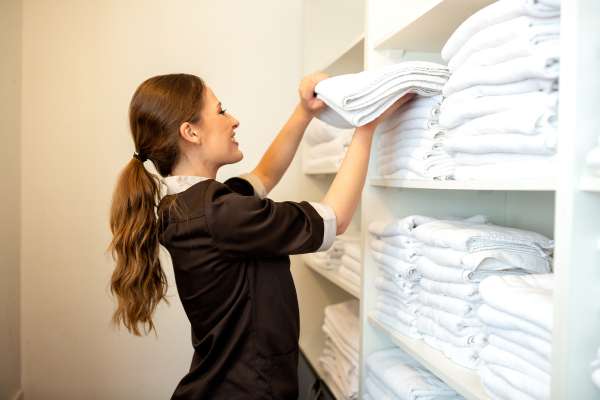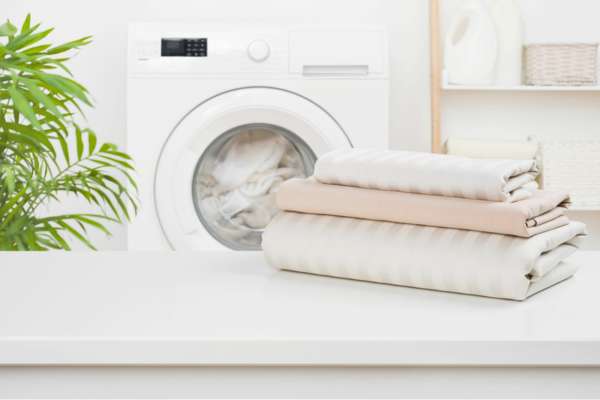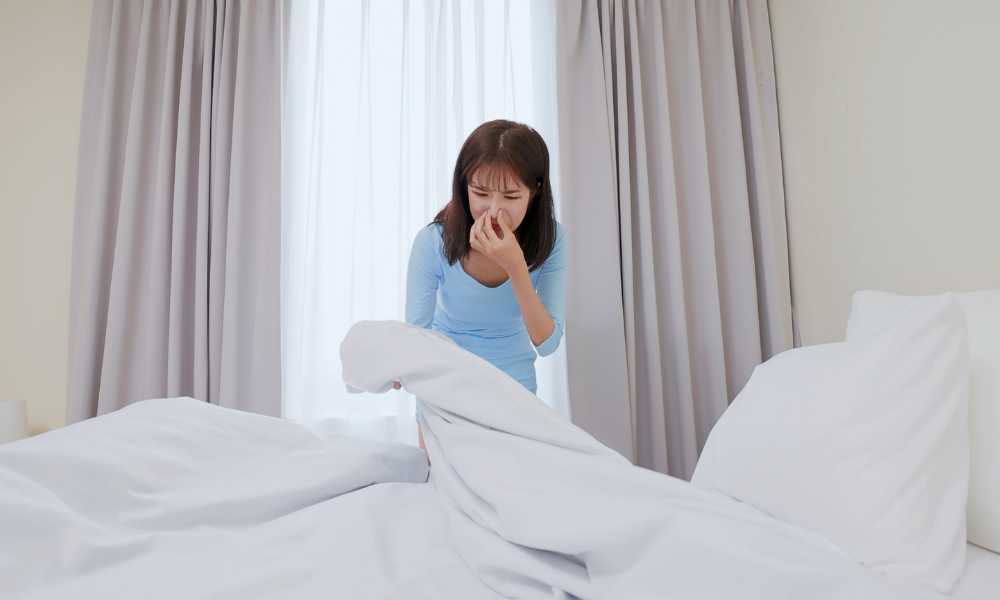Maintaining clean bed sheets is crucial for hygiene and comfort, but traditional washing isn’t always an option due to factors like water scarcity, environmental concerns, or lack of access to laundry facilities. Non-washing cleaning methods offer practical alternatives, preserving the freshness and cleanliness of bed sheets without relying on a washing machine. These methods can be particularly beneficial for those living in areas with water restrictions or for individuals seeking eco-friendly solutions. This guide introduces various techniques to clean bed sheets effectively without traditional washing, ensuring a hygienic sleep environment.
Why Clean Bed Sheets Matter?

Before diving into the unconventional methods, let’s understand why keeping your bed sheets clean is crucial. Dirty bed sheet can harbor dust mites, bacteria, and allergens, leading to skin irritations and respiratory issues. Maintaining a clean sleeping environment contributes to overall well-being.
Pre-Cleaning Preparation

Before proceeding with non-washing cleaning methods for bed sheet, pre-cleaning preparation is essential to ensure effectiveness and ease. Start by gathering the necessary tools and materials. These may include a vacuum cleaner with an upholstery attachment for gentle suction, baking soda for odor neutralization, and a soft-bristled brush for spot treatments.
Once you have your tools ready, carefully remove the bed sheet from the bed. Be gentle to avoid tearing or stretching the fabric, especially if the sheets are damp or heavily soiled. After removing the sheets, take them outdoors if possible. Shake them vigorously to dislodge and remove loose debris, dust, and hair. This action helps in not only getting rid of superficial dirt but also in airing out the fabric, reducing any musty odors.
This pre-cleaning preparation is a critical step in maintaining the longevity of your bed sheet while ensuring they are as clean as possible without a traditional wash. It sets the stage for more targeted cleaning methods that will follow.
Spot Cleaning Techniques

Spot cleaning is an effective technique for treating specific stains on bed sheet without the need for a full wash. The first step in spot cleaning is to identify the type of stain you’re dealing with, as different stains require different treatments.
- Identifying Stains: Common stains on bed sheet include sweat, blood, food, and drink spills. Each type of stain has a unique composition that might necessitate a specific cleaning solution.
- Preparing the Cleaning Solution:
- For protein-based stains like sweat and blood, cold water and a mild detergent work best. Avoid hot water as it can set these stains.
- For oil-based stains, a mixture of baking soda and water can be effective.
- Vinegar is a versatile cleaner suitable for various stains, particularly those that are acidic or tannin-based, like coffee or wine.
- Applying the Cleaning Solution:
- Gently apply the chosen cleaning solution directly onto the stain.
- For delicate fabrics, it’s advisable to test the solution on a small, inconspicuous area first to ensure it doesn’t cause discoloration.
- Blotting Technique:
- Use a clean, white cloth or a paper towel to blot the stain. The key is to dab gently to lift the stain rather than rubbing it, which can cause the stain to spread or the fabric to wear.
- Continue blotting with fresh sections of the cloth or new paper towels until no more of the stain transfers onto the cloth.
- Rinsing:
- After the stain has been significantly lifted, gently rinse the area with cold water to remove any residue of the cleaning solution.
- Avoid soaking the entire sheet; focus just on the stained area.
- Drying:
- Allow the treated area to air dry completely. Avoid using heat or direct sunlight, as this can set any remaining stain particles.
Spot cleaning requires patience and a gentle touch, but with the right techniques, you can effectively remove common stains from bed sheet without needing a full wash. This method is particularly useful for preserving the quality and longevity of your sheets.
Using Baking Soda for Odor Removal

Using baking soda is an effective and natural way to remove odors from bed sheet. This method is gentle on fabrics and ideal for those sensitive to strong scents or chemicals. Here are the detailed steps for using baking soda for odor removal:
- Lay Out the Sheets: Spread your bed sheets flat on a large, clean surface. If possible, do this outside where there’s ample air circulation, or choose a well-ventilated room.
- Sprinkle Baking Soda: Take a box of baking soda and sprinkle it evenly across the entire surface of the bed sheet. Be generous but avoid clumping. For a queen or king-sized sheet, you might need about a cup of baking soda.
- Gently Rubbing Baking Soda In: Using your hands or a soft brush, gently rub the baking soda into the fabric. This helps in better absorption of odors. Be gentle to prevent any damage to the fabric.
- Let it Sit: Leave the baking soda on the bed sheets for at least one hour. For stronger odors, you might consider leaving it for up to 24 hours. The longer it sits, the more time it has to neutralize and absorb odors. Baking soda works by absorbing and neutralizing acidic and basic odor molecules, making it a highly effective deodorizer.
- Remove the Baking Soda: After the set period, thoroughly shake out the sheets to remove the majority of the baking soda. Do this outdoors if possible. Then, use a vacuum cleaner with an upholstery attachment to gently suck up any remaining baking soda from the fabric.
- Air Out the Sheets: Finally, hang the sheets in a well-ventilated area or outdoors. Fresh air and sunlight will further help in removing any lingering odors and freshening up the sheets.
Vacuuming the Bed Sheets

Vacuuming bed sheet is an effective way to remove baking soda after deodorizing, as well as any remaining debris like pet hair, dust, or crumbs. Using a handheld vacuum or an upholstery attachment on a standard vacuum cleaner is ideal for this task. Here’s how to do it:
- Choose the Right Vacuum Attachment: If using a standard vacuum cleaner, attach the upholstery attachment. This attachment is designed to be gentle on fabrics. For smaller or more delicate sheets, a handheld vacuum might be more manageable.
- Prepare the Bed Sheets: Lay the bed sheet flat on a large, clean surface. If you’ve just deodorized them with baking soda, ensure that the baking soda has had enough time to sit.
- Begin Vacuuming: Turn on the vacuum to a low or medium setting, if adjustable. Start from one end of the sheet and slowly move across the surface. Keep the vacuum head or attachment slightly above the fabric, without pressing down too hard. This prevents the fabric from being sucked into the vacuum, which could cause damage.
- Use Gentle, Overlapping Strokes: Move in gentle, overlapping strokes, ensuring you cover the entire surface of the sheet. Be extra careful around any decorative elements or thinner areas of the fabric.
- Focus on Heavily Soiled Areas: Pay special attention to areas that are more prone to dirt accumulation, such as corners or edges that hang closer to the floor when on the bed.
- Check the Sheet Regularly: Periodically stop and check the sheet. If you notice any pilling or damage, adjust your technique, perhaps by holding the vacuum a bit further away from the fabric or reducing the suction power.
- Final Pass: Once you’ve covered the entire sheet, make a final pass to ensure no baking soda or debris is left behind.
- Air Out the Sheets: After vacuuming, it’s a good idea to hang the sheets in a well-ventilated area or outdoors for a short time to air out any residual dust.
Steam Cleaning for Deep Cleaning

Steam cleaning is a powerful method for deep cleaning bed sheet, especially when washing is not feasible. It uses hot steam to kill germs, remove dust mites, and freshen up the fabric. You can use a garment steamer or an iron with a steam setting for this purpose. Here’s a guide on how to do it effectively and safely:
- Selecting the Right Equipment: Choose a garment steamer or an iron with a steam setting. Make sure it’s filled with clean water and is in good working condition.
- Preparing the Bed Sheets: Spread the bed sheet flat on an ironing board or a large, clean surface. If you don’t have an ironing board large enough, you can lay them on a bed, ensuring the surface underneath is heat resistant.
- Heating the Steamer or Iron: Turn on your steamer or iron and allow it to heat up. Wait until it starts producing a consistent flow of steam.
- Steam Cleaning Process:
- If using a garment steamer, hold the steamer head about 6 inches away from the fabric and move it slowly across the bed sheet. Cover the entire surface systematically.
- If using an iron with a steam setting, gently press and move the iron across the bed sheet without making direct contact. The steam should penetrate the fabric.
- Safety Precautions:
- Be cautious of hot steam to avoid burns.
- Never steam-clean electric blankets or sheets with metallic threads.
- Ensure the room is well-ventilated during steam cleaning.
- Allowing the Sheets to Dry: After steam cleaning, let the sheets cool and dry completely. Hang them in a well-ventilated area or outdoors. The sheets should be entirely dry before you place them back on the bed.
- Inspecting the Sheets: After the sheets are dry, inspect them for any remaining stains or odors. If necessary, repeat the steaming process or use other spot-cleaning techniques.
Using a Hairdryer for Quick Freshening

Using a hairdryer for a quick freshening of bed sheet is an efficient and convenient method, especially when you’re short on time. Here’s how to do it:
- Set Up the Hairdryer: Choose a hairdryer with a cool air setting. Using hot air can damage the fabric or cause shrinkage, so it’s important to ensure the hairdryer is in a cool setting.
- Prepare the Bed Sheets: Lay the bed sheet flat on the bed or a large, clean surface. If the sheets are on the bed, straighten them out to remove any wrinkles or folds where dust might be trapped.
- Begin the Freshening Process: Hold the hairdryer about 6-8 inches away from the fabric. Start from one end of the sheet and slowly move across the surface, ensuring you cover the entire sheet. The airflow from the hairdryer will help to blow away dust particles and any loose debris.
- Use Sweeping Motions: Move the hairdryer in sweeping, back-and-forth motions, similar to how you would if drying hair. This ensures even coverage and prevents focusing the airflow too long on any one spot, which could potentially harm the fabric.
- Focus on Areas Prone to Dust Accumulation: Pay special attention to areas that might collect more dust, such as corners or edges. Also, ensure to pass over any creases or folds where dust might be hidden.
- Flip and Repeat: Once you’ve gone over one side of the sheets, flip them over and repeat the process on the other side. This ensures that you’re removing as much dust and debris as possible.
- Air Out the Sheets: After using the hairdryer, it’s a good idea to let the sheets air out for a few minutes. If possible, open a window or turn on a fan to help circulate fresh air through the fabric.
Airing Out the Sheets

Airing out bed sheets is a natural and effective way to freshen them up, reduce odors, and even naturally disinfect them with the power of sunlight and fresh air. Here’s how to do it:
- Choose the Right Location: If possible, hang the sheets outside where they can get direct sunlight. Sunlight has natural disinfecting properties and can help eliminate bacteria and dust mites. If outdoor space isn’t available, choose a well-ventilated indoor area near a window.
- Proper Hanging Technique:
- Use a clean clothesline or drying rack to hang the sheets. Ensure the line or rack is clean to avoid transferring any dirt back onto the sheets.
- Spread the sheets as wide as possible to maximize their exposure to air and sunlight. Avoid folding or bunching them, as this can prevent certain areas from getting adequately aired out.
- Duration of Airing Out:
- Allow the sheets to hang for several hours. Ideally, they should be exposed to direct sunlight for at least 2-3 hours, but longer is better if possible.
- If you’re airing them indoors, leave them for as long as possible in a well-ventilated room with good air circulation.
- Rotating the Sheets:
- If you have the opportunity, rotate or flip the sheets halfway through the airing process. This ensures all parts of the sheets get equal exposure to sunlight and air.
- Safety Precautions:
- Be mindful of weather conditions. Avoid airing out sheets on days with high humidity, as this can make them damp and promote the growth of mildew.
- Also, consider the outdoor environment – avoid hanging sheets outside in areas with a lot of pollution or dust.
- The Benefits of Fresh Air and Sunlight:
- Sunlight can help to naturally whiten sheets and remove stubborn stains.
- Fresh air helps to ventilate the fabric, removing odors and leaving sheets smelling fresh and clean.
Applying Fabric Fresheners or Essential Oils
Applying fabric fresheners or essential oils is a great way to give your bed sheet a pleasant, refreshing scent, contributing to a more relaxing and sleep-friendly environment. Here’s how to do it effectively:
- Choosing the Right Freshener:
- Opt for a fabric freshener that is specifically designed for bedding and is gentle on fabrics. Look for products with natural ingredients to avoid potential skin irritation.
- Alternatively, create a homemade spray by mixing water with a few drops of essential oils. Essential oils like lavender, chamomile, or eucalyptus are known for their calming properties and can promote relaxation and better sleep.
- Making a Homemade Essential Oil Spray:
- Combine about a cup of water with 5-10 drops of your chosen essential oil in a spray bottle. Shake well to mix.
- For a more lasting scent, you can add a small amount of unscented witch hazel or rubbing alcohol, which helps to disperse the oil more evenly.
- Applying the Freshener:
- Lightly spritz the fabric freshener or essential oil mixture onto the bed sheets. Hold the spray bottle about 6 inches away from the fabric to ensure a fine mist.
- Be cautious not to oversaturate the sheets; a light misting is sufficient.
- Allowing the Sheets to Dry:
- After applying the freshener, let the sheets air dry completely before making the bed. This prevents any moisture buildup which can lead to mildew.
- Selecting Scents for Relaxation and Sleep:
- When choosing scents, consider those that are known for their calming effects. Lavender is a popular choice for promoting relaxation and sleep.
- Alternatively, scents like eucalyptus or peppermint can be refreshing and help clear nasal passages, which might be beneficial for those with allergies or colds.
- Testing for Sensitivity:
- If you have sensitive skin, it’s a good idea to test the freshener on a small area of the sheet first to ensure it doesn’t cause any irritation.
Conclusion and Regular Maintenance Tips
Maintaining clean and fresh bed sheet is more than just a matter of hygiene; it’s essential for ensuring a comfortable and healthy sleep environment. Regular cleaning and maintenance of bed sheets, even without traditional washing, can significantly contribute to their longevity and overall well-being.
Summarizing the Importance of Regular Sheet Maintenance:
- Regular cleaning helps to remove dust, skin cells, and other allergens that accumulate over time, which can aggravate allergies and skin irritations.
- Fresh sheets contribute to a more pleasant and relaxing sleep experience, which is crucial for overall health and well-being.
- Non-traditional cleaning methods like vacuuming, steam cleaning, and using baking soda or essential oils can effectively maintain the cleanliness and freshness of your sheets between washes.
Frequency of Cleaning:
- Even if you’re using non-washing methods, it’s recommended to clean your sheets at least once every two weeks. However, if you have allergies or sweat heavily, you might want to clean them more frequently.
- Regular airing out and spot cleaning can help maintain your sheets between deeper cleaning sessions.
Opting for Traditional Washing:
- While non-washing methods are effective for maintenance, it’s important to periodically wash your sheets. This is especially true if they become heavily soiled, or if you’ve been ill.
- Aim to wash your bed sheets in a washing machine every 4-6 weeks, depending on usage and personal needs.
Final Tips for Bed Sheet Care:
- Rotate between at least two sets of sheets to reduce wear and tear on each set.
- Always follow the care instructions specific to your bed sheets’ material to prevent damage during cleaning.
- Be mindful of the products you use, especially if you have sensitive skin. Opt for natural, gentle cleaners wherever possible.
Regular and proper maintenance of bed sheets is a key aspect of household hygiene and personal health. Integrating both non-washing and traditional washing methods into your routine will ensure your bed remains a clean, comfortable, and inviting space.
